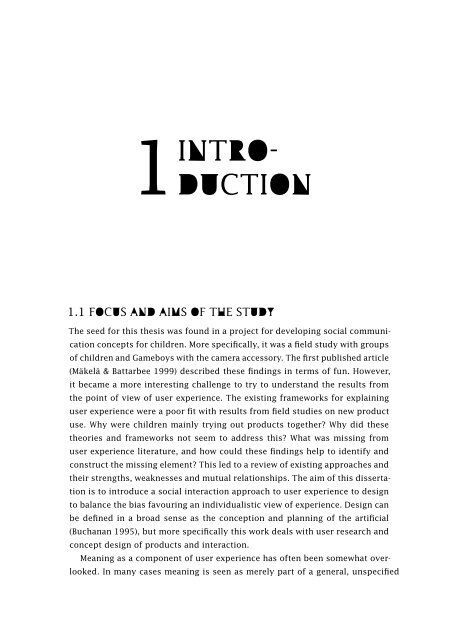Co-experience: Understanding user experiences in social interaction
Co-experience: Understanding user experiences in social interaction
Co-experience: Understanding user experiences in social interaction
You also want an ePaper? Increase the reach of your titles
YUMPU automatically turns print PDFs into web optimized ePapers that Google loves.
1 INTRO -<br />
DUCTION<br />
1.1 FOCUS AND AIMS OF THE STUDY<br />
The seed for this thesis was found <strong>in</strong> a project for develop<strong>in</strong>g <strong>social</strong> communication<br />
concepts for children. More specifically, it was a field study with groups<br />
of children and Gameboys with the camera accessory. The first published article<br />
(Mäkelä & Battarbee 1999) described these f<strong>in</strong>d<strong>in</strong>gs <strong>in</strong> terms of fun. However,<br />
it became a more <strong>in</strong>terest<strong>in</strong>g challenge to try to understand the results from<br />
the po<strong>in</strong>t of view of <strong>user</strong> <strong>experience</strong>. The exist<strong>in</strong>g frameworks for expla<strong>in</strong><strong>in</strong>g<br />
<strong>user</strong> <strong>experience</strong> were a poor fit with results from field studies on new product<br />
use. Why were children ma<strong>in</strong>ly try<strong>in</strong>g out products together? Why did these<br />
theories and frameworks not seem to address this? What was miss<strong>in</strong>g from<br />
<strong>user</strong> <strong>experience</strong> literature, and how could these f<strong>in</strong>d<strong>in</strong>gs help to identify and<br />
construct the miss<strong>in</strong>g element? This led to a review of exist<strong>in</strong>g approaches and<br />
their strengths, weaknesses and mutual relationships. The aim of this dissertation<br />
is to <strong>in</strong>troduce a <strong>social</strong> <strong>in</strong>teraction approach to <strong>user</strong> <strong>experience</strong> to design<br />
to balance the bias favour<strong>in</strong>g an <strong>in</strong>dividualistic view of <strong>experience</strong>. Design can<br />
be def<strong>in</strong>ed <strong>in</strong> a broad sense as the conception and plann<strong>in</strong>g of the artificial<br />
(Buchanan 1995), but more specifically this work deals with <strong>user</strong> research and<br />
concept design of products and <strong>in</strong>teraction.<br />
Mean<strong>in</strong>g as a component of <strong>user</strong> <strong>experience</strong> has often been somewhat overlooked.<br />
In many cases mean<strong>in</strong>g is seen as merely part of a general, unspecified

















